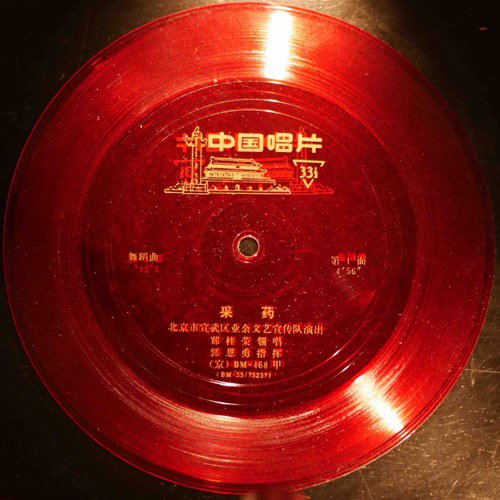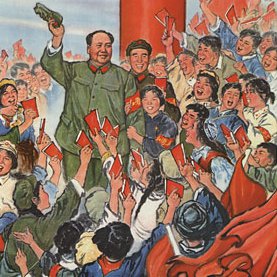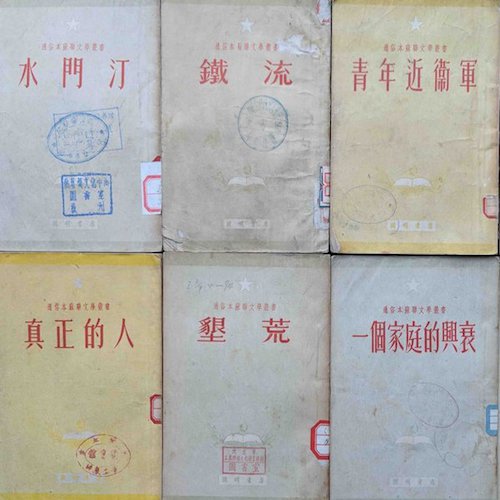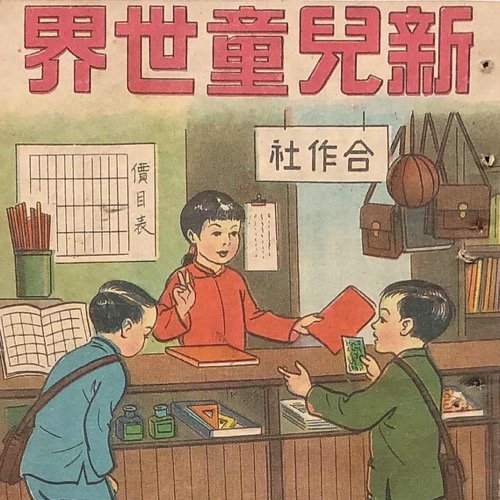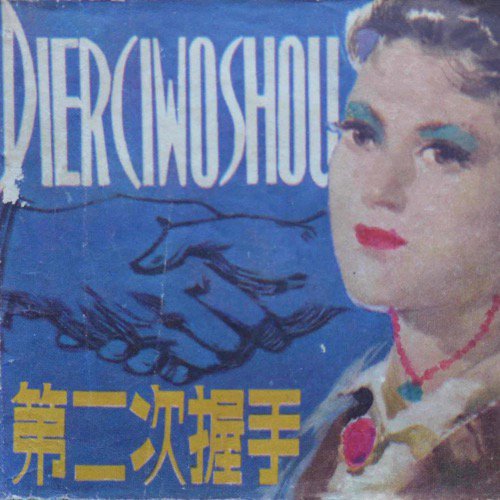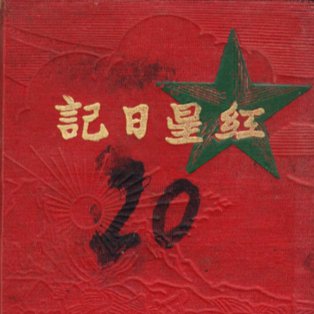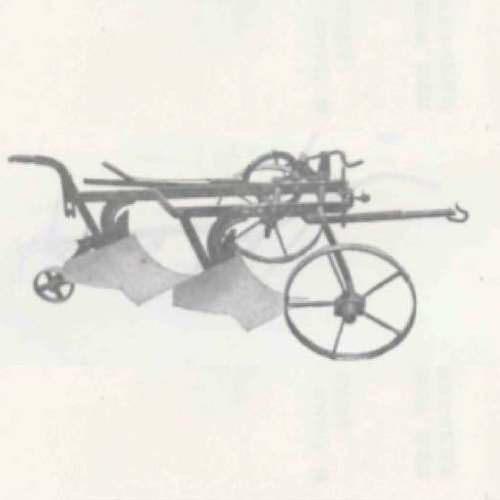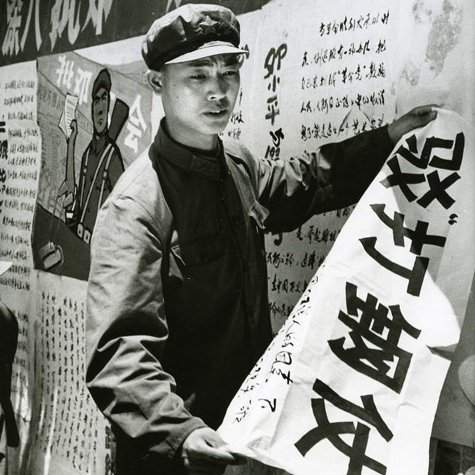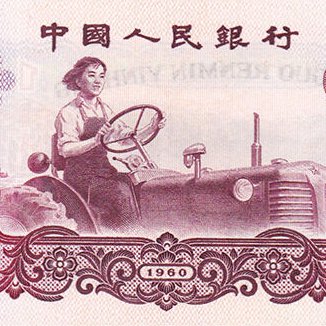Thomas S. Mullaney, Stanford University
Summary
The history of Chinese typewriting is one of experiments, prototypes, failures, and successes in the century-long quest to solve a complex design puzzle: How to fit thousands of characters on a desktop device? The history of Chinese typewriting is also a unique lens through which to examine the broader histories of Chinese mass mobilisation, science and technology, literacy, women, industry, and cultural work.The Origins of Chinese Typewriting
When you hear the words 'Chinese typewriter,' what images jump to mind? A keyboard with thousands of keys? A massive machine? If so, you wouldn’t be alone—although you would be wrong. From turn-of-the-century cartoons [see ⧉source: Cartoon mocking the Chinese typewriter] to MC Hammer [see ⧉source: 'Chinese typewriter' dance] and The Simpsons [see ⧉source: Lisa Simpson using a 'Chinese typewriter'], strange ideas about Chinese typewriters have circulated in the West, often as a way to poke fun at the Chinese language and to demonstrate the supposed superiority of alphabetic languages.
Real Chinese typewriters looked nothing like these imaginary ones, however. First of all, they were much smaller than often assumed. And even more startlingly, they did not have thousands of keys—in fact, they had no keys or keyboard at all.
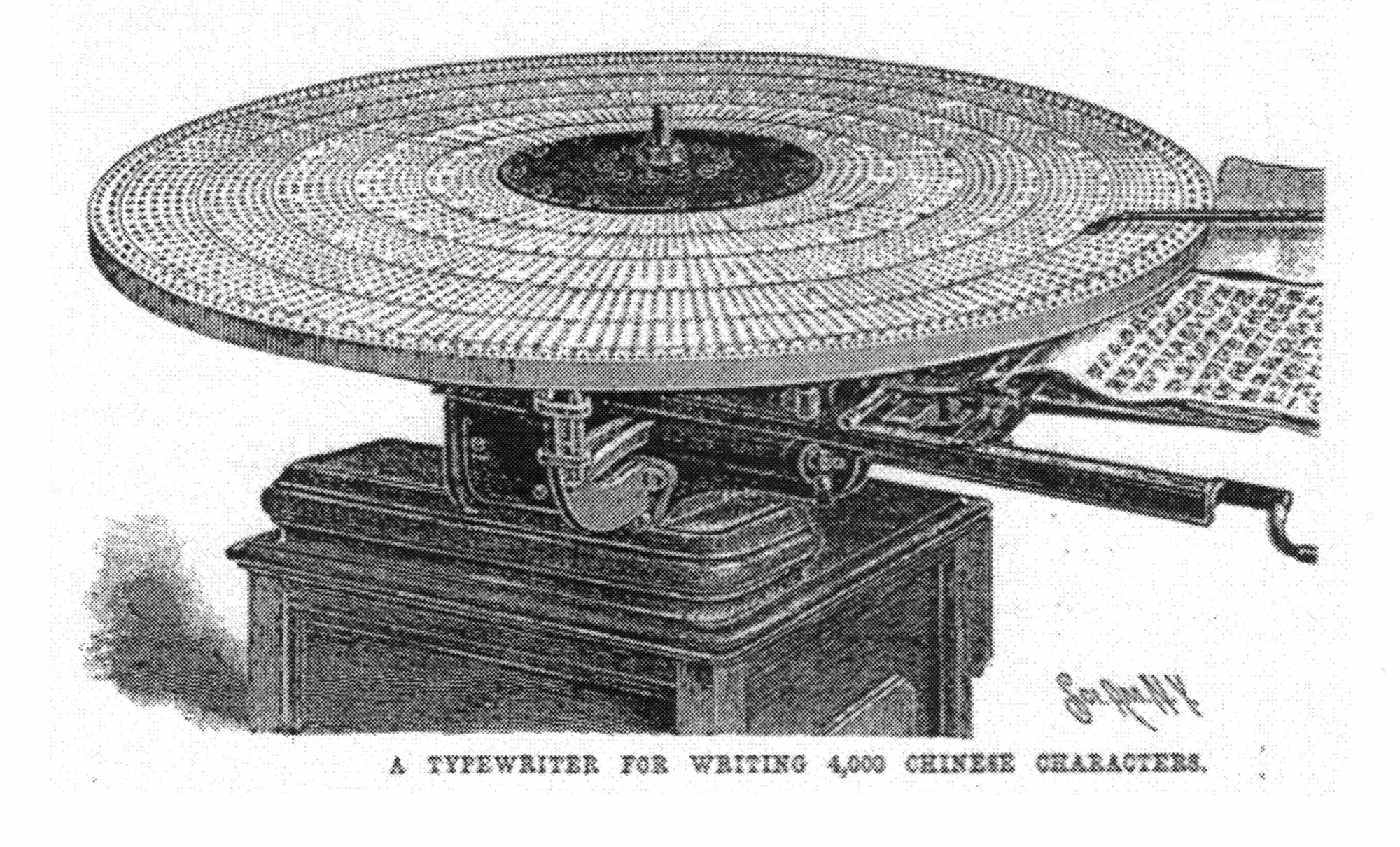
The first experimental Chinese typewriter was designed and developed by Devello Zeletos Sheffield, an American Protestant missionary working in Tongzhou, China. Sheffield began developing his apparatus starting in the 1880s, and over the next decade built a machine featuring 4,662 commonly used Chinese character arranged on a wheel in 30 concentric rings. [See ⧉source: First Chinese typewriter, invented by Devello Sheffield, also depicted to the left] The characters were divided into regions of 'special,' 'very common,' 'common,' and 'less common' usage. By rotating the wheel, and moving the table closer and further from the operator, each of the characters could be brought into the typing position and inscribed on the page. Sheffield’s machine gained a great deal of fanfare in the Western press, but was never manufactured or sold on the market largely because of its prohibitive cost.
China’s Republican period (1911-1949) witnessed the first mass-manufactured Chinese typewriters. Building on the common usage method, two Chinese inventors went on to produce the first commercially manufactured machines: Zhou Houkun and Shu Zhendong. Born in 1889, Zhou graduated from the Massachusetts Institute of Technology in 1915 with a Masters of Science in Aeronautical Engineering (the first such degree ever awarded in the United States).
After learning of Zhou Houkun’s work in the mid-1910s, executives at Commercial Press—one of China’s most important publishers, based in Shanghai—promptly offered him a position in the company, and supported his efforts to design a marketable device. When Zhou’s initial efforts proved unsuccessful, he left the Commercial Press, to be replaced by Shu Zhendong. Shu went on to develop the 'Shu-Style Chinese Typewriter,' the first mass-produced Chinese typewriter in history. [See ⧉source: the 'Shu Zhendong Chinese typewriter']
Commercial Press dedicated significant resources to promoting the machine. [See⧉source: Commercial press Chinese typewriter manufacturing plant] Representatives of the company went on a tour of present-day Southeast Asia to promote the machine among overseas Chinese communities, and the machine was featured in the Chinese exhibit at the 1926 World’s Fair in Philadelphia. China’s first-ever animated film was an advertisement for the Shu-Style machine.
The Double Pigeon: The Emblematic Chinese Typewriter of the Maoist Period
Although invented before 1949, Chinese typewriting experienced its 'golden age' during the Maoist period. With its signature pale green color, the 'Double Pigeon'-brand Chinese typewriter in particular was the typewriter of the post-1949 era [see ⧉source: Double Pigeon Chinese typewriter]. Produced by the Shanghai Calculator and Typewriter Factory, it was manufactured from the 1950s well into the 1980s and early 1990s. In March 1956, the Chinese typewriter even appeared in its first Mao-era propaganda poster [see ⧉source: Mao-era propaganda poster featuring Chinese typist].
Following the Communist revolution of 1949, the machine was used more than ever before, by government offices, universities, and businesses, and could be found all the way from the metropolitan areas of Beijing, Shanghai, Harbin, and Kunming to remote regions of western China. No later than May 1950, the Political Protection Office of the Harbin Municipal Bureau of Public Security began to type up its surveillance reports, as shown in local investigations of Catholic communities. In Beijing, typewritten reports from the Beijing Municipal Vice Food Products Industry Party appear no later than 1952. Provincial-level Party secretaries in Hebei began producing typewritten documents no later than 1955.
Typewriting was not limited to larger urban centers, moreover. In the county of Baoji in Shaanxi province, typewritten documents appear by 1957 in survey reports on local conditions. Most telling of all, typewritten reports from 1956 and 1957 were produced in the remote pastoral region of Zeku county, in Qinghai province.
How Do You Type Without a Keyboard? Typing Schools in Maoist China
Whether for English, Russian, Hebrew, or Arabic, typewriters around the world featured keyboards. Not so for Chinese typewriters, which featured a grid of movable type Chinese characters called a 'tray bed' (zipan 字盘) containing approximately 2,500 characters in all. Each Chinese character on the tray bed was a loose, metal slug, similar to movable type.
With their left hand, the typist moved this character tray bed left and right. With their right hand, they move a mechanical arm over top of the character they wanted, and pressed a type lever [see ⧉source: Video demonstrating use of Chinese typewriter]. Doing so caused the machine to lift the Chinese character slug into a type chamber, which then swung up rapidly and struck the paper, before falling back and returning the slug back to its original location as the typist moved on [see ⧉source: Diagram showing how to use a Chinese typewriter].
How did Chinese typists memorize the locations of so many characters? First of all, they didn’t. Unlike alphabetic typewriting, where typists were trained not to look at the keyboard, Chinese typists relied heavily on their vision. Their job was to learn the general 'neighborhoods' or 'regions' where each character was located, so that they could bring the type selector there and then locate the precise location of the character they wanted. Even that is a challenging feat of memory, however, so how was it done?
With the spread of this new technology, an equally and well-trained clerical labor force became necessary: a battery of trained 'typists' (daziyuan 打字员) to take up posts in government, education, finance, and the private sector, and to put these new machines to work. [See ⧉source: Chinese typist demonstrating machine at trade show] To meet this need, public and private typing institutes sprang up in Shanghai, Beijing, Tianjin, Chongqing, and other metropolitan areas. Here, young women—and quite a few young men—received training in the new technology, typically in small, one- or two-classroom institutes over the course of one to three months. [See ⧉source: Image of female Chinese typist] Predominantly lower- or middle-school-educated, these students graduated from typing institutes in sizable numbers and went on to work in banks, government offices, universities, and other industries. Some went on to found typing schools of their own.
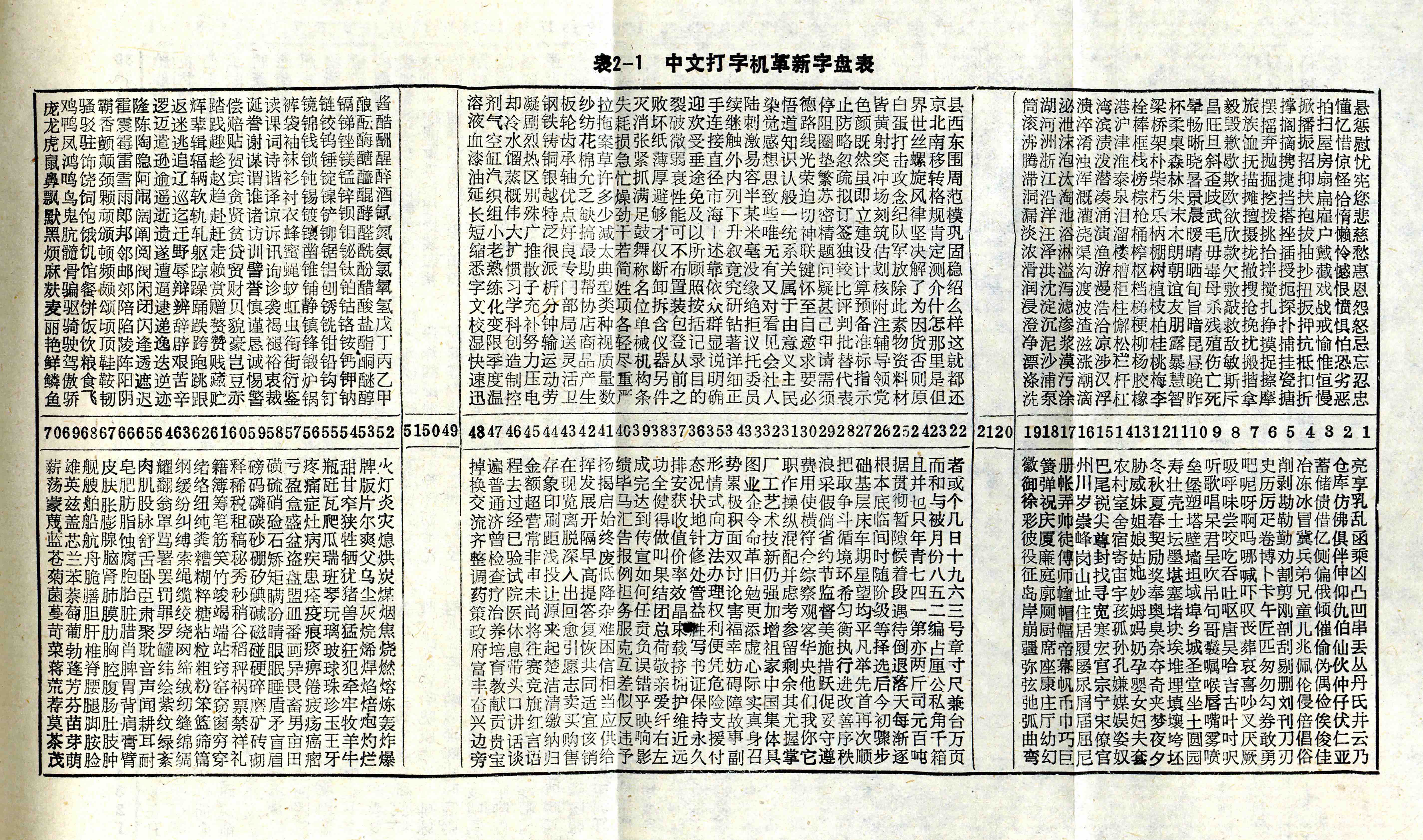
Typists learned to navigate the new machine, familiarizing themselves with the general locations of nearly 2,500 Chinese characters [see ⧉source: Chinese typewriter tray bed guide, also depicted to the right]. Typing lessons typically began with a set of repetitive drills, beginning with common, two-character Chinese words—such as 'student' (made up of the characters xue 学 and sheng 生), or 'because' (yin 因 and wei 为), and hundreds of others. By repeating xue-sheng-xue-sheng, yin-wei-yin-wei, over and over, these drills imprinted a kind of 'muscle memory' in students, helping them remember, if not the absolute x-y coordinates of characters, then at least the geometric patterns between those Chinese characters that tended to go together in actual writing.
The Role of Chinese Typewriters in Bureaucracy, Mass Campaigns, and Propaganda
The Maoist period was a practically never-ending series of mass mobilization campaigns. These placed an unprecedented burden on Chinese typists. Practically every week, they had to prepare and circulate new materials for 'political study sessions' taking place in work units across the country. In most cases, these study sessions required anywhere from 10 to 100 copies of a given text, far less than the number needed to make printing presses a useful option, but also too much to copy by hand. (Presses were expensive, technically challenging to operate, and required extensive preparation, and thus were justifiable only for print runs of 100s to many thousands.) Using a Chinese typewriter and a mimeograph machine, a typist could prepare crisp and legible copies of political speeches, study guides, statistics, and more.
So heavy was the burden on typists, that some work units could not keep up with the workload using just their own typewriter pool. In such cases, some resorted to 'outsourcing' these jobs to unofficial 'type-and-copy shops' (dazi tengxieshe 打字誊写社), a phenomenon that raised concerns within the Chinese Communist state (even though they too recognized the need for it). With the proliferation of small-scale, independently operated typing shops, after all, the Chinese Communist Party ran the risk of losing its monopoly over the means of textual production.
Homemade Books and DIY Journals
It was not only reports and government memos that were reproduced using typewriters and mimeograph machines, but also entire journals and books. In the Mao era, an entirely new kind of Chinese book was born: the 'typed-and-mimeographed edition' (dazi youyinben 打字油印本, often referred to in shorthand as dayinben 打印本), made possible thanks to the combination of Chinese typewriters and mimeograph machines [see ⧉source: 'Typed-and-mimeographed' book]. In one such book, members of the 'Yunnan University Mao Zedong-ism Artillery Regiment Foreign Language Division Propaganda Group' typed-and-mimeographed Mao’s speeches delivered during the years 1957 and 1958, copied from the People’s Daily, the China Youth Daily (Zhongguo qingnian 中国青年), the New China Bimonthly (Xinhua banyuekan 新华半月刊), Henan Daily (Henan ribao 河南日报), and others. Extending to over 280,000 characters in length, with page after page of densely packed typewritten text, this work would have taken between 100 and 200 hours—or four to eight full days—to type and mimeograph. This may sound like an overwhelming amount of time, except when one compares it to how long the same work would have required if copying by hand, or if using a much costlier printing press. This technique also afforded one a greater deal of flexibility, making it possible to prepare a master copy using a Chinese typewriter, but then adjusting or adding to that master copy by hand, using a hard-edged tool. This enabled one to produce texts that would comparatively more difficult using conventional printing press techniques, as seen in a typed-and-mimeographed musical score from the era. [See ⧉source: Mao-era musical score printed using a typewriter, hand-held tools, and a mimeograph machine]
'Model Typists' and the Origins of 'Predictive Text'
Because of the increased popularity of Chinese typewriters, and also because of the unprecedented workloads for typists during the many political campaigns of the period, Mao-era Chinese typists began to experiment with radically new ways of organizing the Chinese characters on their typewriter tray beds. Instead of using the standard 'out-of-the-box' layout—a layout based upon the organization of Chinese dictionaries at the time—they begin to rearrange characters so that characters which tended to appear together in the Chinese language were as close together on the machine as possible [see ⧉ source: Diagram explaining principle of new typewriter tray bed layout]. Originally, for the example, the character 'mao' (毛) of 'Mao Zedong' was located on the tray bed at a considerable distance from the characters 'ze' (泽) and 'dong' (东)—costing time and energy and typists typed the name 'Mao Zedong.' Their answer to this challenge was to abandon the conventional, dictionary-like arrangement of characters, and to replace it with what we would now term 'natural language,' or even 'predictive text,' arrangements. They placed 'mao,' 'ze' and 'dong,' right next to one another; and, furthermore, they placed these characters as close as possible to other Chinese terms like 'zhu' (主) and 'xi' (席) (which, when strung together, form the three-character term 'Mao zhuxi' 毛主席 or 'Chairman Mao').
Typists called the new arrangement 'radiating style' (fangsheshi paizi 放射式排字) and, more often, lianxiang (联想), or 'connected thought.' Thanks to this pioneering work, the most skilled Chinese typists were able to triple their typing speeds, from around 20 to around 60 characters per minute, simply by changing the layout of the tray bed.
The Chinese government began to celebrate these experiments and the 'model typists' who led them. In November 1953, for example, the People’s Daily (the main mouthpiece of the Chinese Communist Party) featured a story about Shen Yunfen, a young woman who had joined the People’s Liberation Army as a typist two years prior, at the age of seventeen. Eager to carry out her work as efficiently as possible, the article explained, Shen began to experiment with natural-language arrangements, increasing her typing speed from around two thousand to nearly 3,400 characters per hour. On January 25, 1953, the young Shen was granted the title of 'First-Class Hero' and 'second-level model worker.' In September 1955, she was received by Mao Zedong himself at the National Conference of Youth Activists in Socialist Construction.
Legacies: From Chinese Typewriting to Chinese Computing
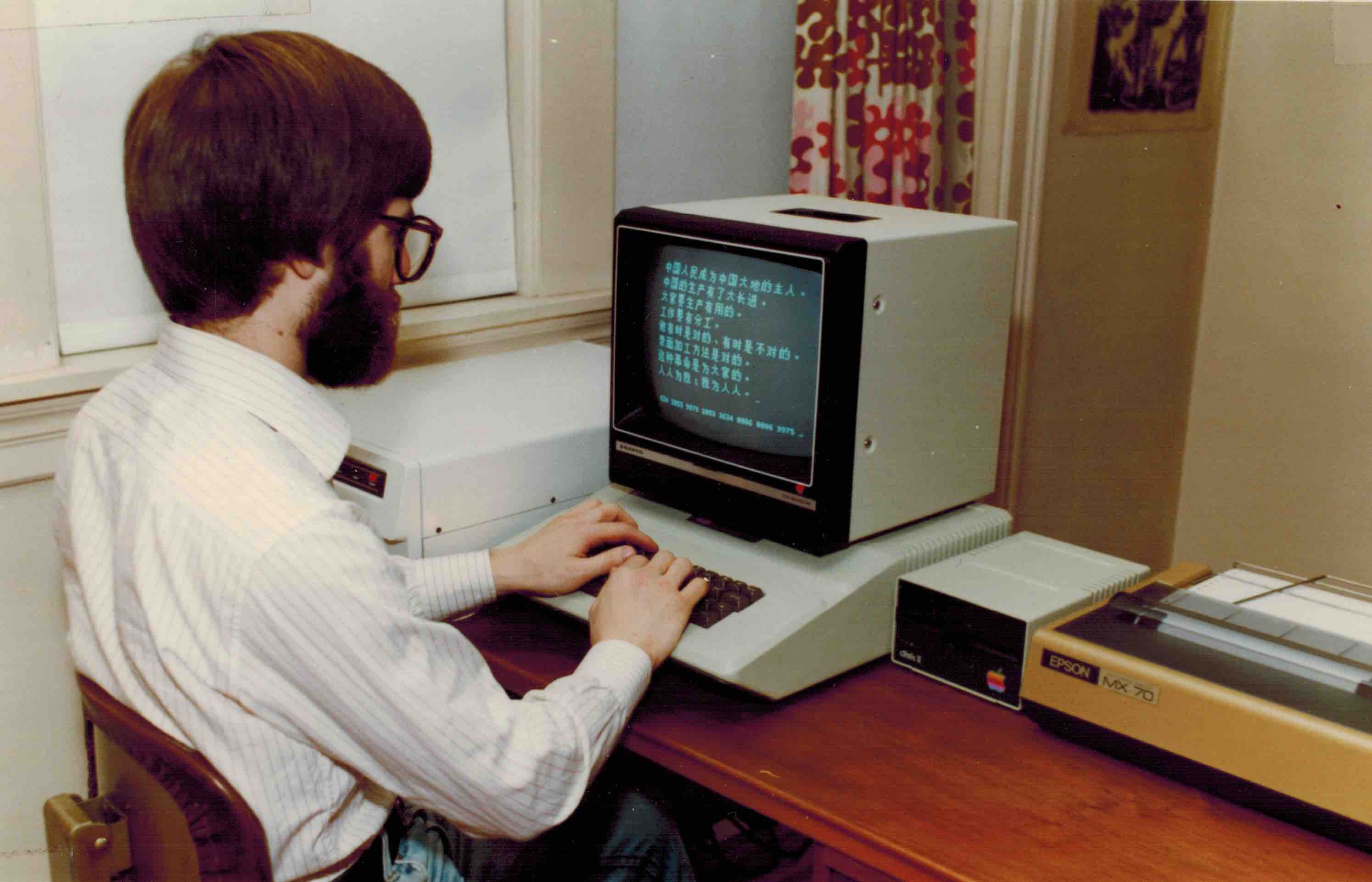
The last Chinese typewriter rolled off the assembly line sometime around 1991. The machines were replaced by new technologies, such as word processors and computers [see ⧉source: Sinotype III Chinese personal computer, also depicted to the left]. Both the challenges and innovations lived on, however. First, the 'predictive text' techniques created by typists became the basis of Chinese computing systems as early as the 1970s and gave their name to the world’s second-largest personal computer manufacturer, Lianxiang — or, as the firm prefers to be known in English, Lenovo. Second, 'typed-and-mimeographed' books and journals continued to be produced during the post-Mao period, and in even greater numbers [see ⧉source: Post-Mao era 'typed-and-mimeographed' journal]. Indeed, the nationally circulated Reform Era literary journal Today!, described by Liansu Meng as the 'first unofficial journal in China since 1949,' was composed using Chinese typewriters and mimeograph machines.
The most important legacy of the Chinese typewriter was the puzzle it represented—namely, the puzzle of how to fit a writing system with tens of thousands of characters on an easy-to-use, table-top device. This challenge resurfaced many times, whether in the context of Chinese computing and word processing, or more recently, in the context of text input on smart phones and mobile devices. As in the case of predictive text, engineers and linguists working in the age of computing and new media have, time and again, taken many of their cues (and even many of their design strategies) from the domain of Chinese typewriting, whether consciously or not.
Sources
- ⧉ IMAGE
- 文 TEXT
- ▸ VIDEO
- ♪ AUDIO
- ⧉Image Typewriters: Cartoon
- ▸Video Typewriters: MC Hammer
- ⧉Image Typewriters: Lisa Simpson Using A 'Chinese Typewriter'
- ⧉Image Typewriters: Sheffield Machine
- ⧉Image Typewriters: The Shu Zhendong Chinese Typewriter
- ⧉Image Typewriters: Manufacturing Plant
- ⧉Image Typewriters: Double Pigeon
- ⧉Image Typewriters: Mao-era Propaganda Poster Featuring Chinese Typist
- ▸Video Typewriters: Video Demonstrating Its Use
- ⧉Image Typewriters: Diagram Showing How To Use A Chinese Typewriter
- ⧉Image Typewriters: Chinese Typist Demonstrating Machine At Trade Show
- ⧉Image Typewriters: Image Of Female Chinese Typist
- ⧉Image Typewriters: Tray Bed Guide
- ⧉Image Typewriters: 'Typed-and-mimeographed' book
- ⧉Image Typewriters: Mao-era Musical Score
- ⧉Image Typewriters: Diagram Explaining Principle Of New Tray Bed Layout
- ⧉Image Typewriters: Sinotype 3
- ⧉Image Typewriters: Post-Mao era 'Typed-and-mimeographed' Journal
Timeline
Further Reading
Arbisser, Micah Efram. 'Lin Yutang and his Chinese Typewriter'. Senior Thesis no. 13048. Princeton University, 2001.
Arnold, David. Everyday Technology: Machines and the Making of India’s Modernity. Chicago: University of Chicago, 2013.
Beeching, Wilfred A. Century of the Typewriter. New York: St. Martin’s Press, 1974.
Davies, Margery W. Woman’s Place Is at the Typewriter: Office Work and Office Workers 1870–1930. Philadelphia: Temple University Press, 1982.
Gitelman, Lisa. Scripts, Grooves, and Writing Machines: Representing Technology in the Edison Era. Stanford: Stanford University Press, 2000.
Hunter, Janet. 'Technology Transfer and the Gendering of Communications Work: Meiji Japan in Comparative Historical Perspective'. Social Science Japan Journal vol. 14, no. 1 (Winter 2011): 1–20.
Inoue, Miyako. 'Stenography and Ventriloquism in Late Nineteenth-Century Japan.' Language and Communication vol. 31 (2011): 181–190.
Jacobowicz, Seth. Writing Technology in Meiji Japan: A Media History of Modern Japanese Literature and Visual Culture. Cambridge, MA: Harvard University Asia Center, 2016.
Keep, Christopher. 'The Cultural Work of the Type-Writer Girl'. Victorian Studies vol. 40, no. 3 (Spring 1997): 401–426.
Kittler, Friedrich A. Gramophone, Film, Typewriter. Trans. Geoffrey Winthrop-Young and Michael Wautz. Stanford: Stanford University Press, 1999.
Mathias, Jim and Thomas L. Kennedy (eds.). Computers, Language Reform, and Lexicography in China. A Report by the CETA Delegation. Pullman, WA: Washington State University Press, 1980.
Mullaney, Thomas S. 'QWERTY in China: Chinese Computing and the Radical Alphabet'. Technology and Culture vol. 59, no. 4 (October 2018): S34-S65.
-----. 'Shift CTRL: Computing and New Media as Global, Cultural, Sociopolitical, and Ecological'. Technology and Culture vol. 59, no. 4 (October 2018): S1-S6.
-----. The Chinese Typewriter: A History. Cambridge, MA: MIT Press, 2017.
-----. 'Controlling the Kanjisphere: The Rise of the Sino-Japanese Typewriter and the Birth of CJK'. Journal of Asian Studies (August 2016): 725-753.
-----. 'The Moveable Typewriter: How Chinese Typists Developed Predictive Text during the Height of Maoism'. Technology and Culture vol. 53, no. 4 (October 2012): 777-814.
Strom, Sharon Hartman. Beyond the Typewriter: Gender, Class, and the Origins of Modern American Office Work, 1900–1930. Chicago: University of Illinois Press, 1992.
Jing Tsu. Sound and Script in Chinese Diaspora. Cambridge, MA: Harvard University Press, 2011.
Williams, R. John. 'The Technê-Whim: Lin Yutang and the Invention of the Chinese Typewriter'. American Literature vol. 82, no. 2 (2010): 389–419.
